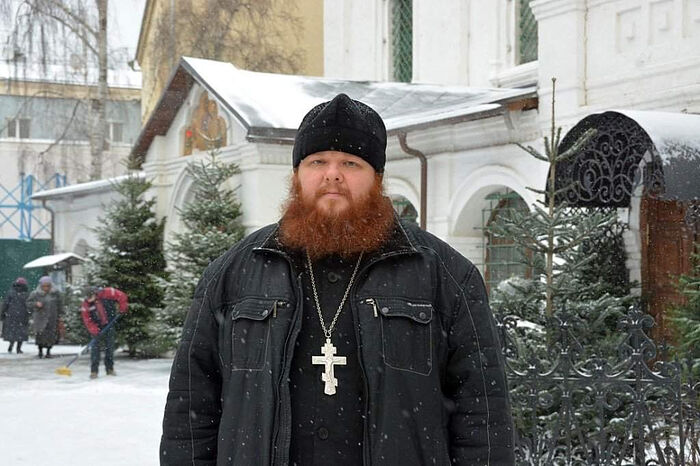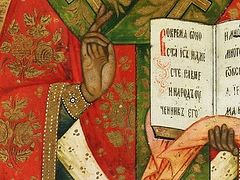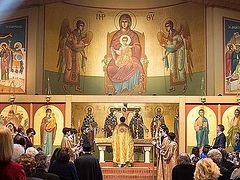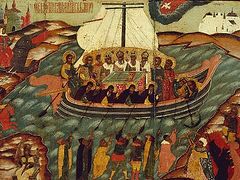In the name of the Father, and of the Son, and of the Holy Spirit!
Today we are celebrating the Triumph of Orthodoxy. Everyone knows that this Church feast was established in honor of the restoration of the veneration of icons in the ninth century. And every year on the first Sunday of Great Lent we still gather in churches and with special prayers and services glorify holy icons of the Lord and our Savior Jesus Christ, the Most Pure Mother of God and all the saints of God. We also venerate the Holy Cross, which became the instrument of our salvation. These visible, tangible relics are strongly associated with the concept of Orthodoxy. And if you ask a foreigner or a non-Orthodox what he knows about the faith of Orthodox Christians, then you will surely hear that they are those who have icons and crosses in their churches and homes, they venerate and kiss them, and wear a cross on their chests. Outwardly, yes, it is so. But why are these icons and crosses so important to us? Why are the domes of churches, frescoes and mosaics display images of all that’s holy so dear to the believing heart and pleasant to the eye? Because we are citizens of the Heavenly Fatherland, and the Church is the image of Heaven on earth. So, the Church is an icon of our homeland, and the Orthodox soul feels this. Man himself is the image of God, and this image was assumed by Christ, the Son of God, for our salvation. It was the incarnation of God, the coming into the world of the Word of God in human flesh that became the basis for the veneration of holy icons. And that is precisely why the enemy of mankind (both 1000 years ago and now) so strongly opposes Orthodoxy, which preserves the veneration of icons as an integral part of our faith.
After being born of the Most Pure Virgin Mary, the Lord forever made it possible for us to see, hear and touch Him. We see an image of the Savior of the world in the form of an Infant in the arms of His Most Pure Mother, Joseph the Betrothed and Simeon the God-Receiver. On church frescoes and in miniatures of texts there are Gospel stories, Christ’s preaching, His miracles, His Sacrifice on the Cross and Resurrection. In the Gospel we hear the Word of God, and finally in the Holy Gifts of the Body and Blood of Christ we touch God Himself with fear and trembling. This is the wisdom and love of the Creator. Not only did He create us as His image, but He also endowed us with the full ability to behold Him and commune with Him, looking at His holy image.
Some will ask: “Can we pray without icons?” Of course we can. And we must pray, as the Savior Himself instructed us; and the Apostle Paul echoed Him: Pray without ceasing (1 Thess. 5:17). The icon is our help in prayer, a guide, a reminder to us of the Heavenly realm. Many call the icon a window to the spiritual realm. Imagine yourself to be in the midst of desert heat and thirst. And suddenly on your way you can see an oasis with a cool stream and green grass. It reminds you of a cool dense Russian forest with tall fir trees, mushrooms in a forest glade and fish-filled lakes. Or, on the contrary, in a cold winter, when it is chilly and there is a blizzard outside, a Christmas cactus blooms on your window, and looking at it you remember a warm summer, the sun, and golden wheat fields. Or far away from your homeland you look at your mother’s photo and feel as if you have returned to your unclouded childhood, full of parental love and warmth. Holy icons have the same effect on us, reminding us of Heaven, in our mind bringing us back to the fatherland of God the Father. But icons serve us not only as reminders of Heavenly things and as helps in prayer. Many of them are also channels of the grace of God, through which the Lord works miracles. One of these is the Vladimir Icon of the Mother of God, in honor of which our Sretensky Monastery was founded. On this day of the Triumph of Orthodoxy we will not see mass celebrations in city squares, we will not see parades and fireworks that take place at secular holidays, and there will be no concerts, loud congratulations and banquets—because this celebration takes place in the quiet cell of the soul of every Orthodox Christian. In this cell there are is candle of prayer, an image of Christ, and the Lord Himself Who came to us in the Holy Gifts. Amen.





